J Lipid Atheroscler.
2012 Dec;1(2):79-86. 10.12997/jla.2012.1.2.79.
The Association between Thigh Circumference and Lipids Profile in Korean Population: The Korea Medical Institute Study
- Affiliations
-
- 1Department of Epidemiology and Health Promotion, Institute for Health Promotion, Graduate School of Public Health, Yonsei University, Seoul, Korea. jsunha@yuhs.ac
- 2The Korea Medical Institute, Seoul, Korea.
- KMID: 2198365
- DOI: http://doi.org/10.12997/jla.2012.1.2.79
Abstract
OBJECTIVE
We performed a study of the relationship between thigh circumference and serum lipids.
METHODS
A total of 314,842 Korean men and women aged 30 to 79 enrolled in the Korea Medical Institute for medical examination between February 2010 and December 2011 were included. Multiple logistic regression analysis was performed to examine the association of thigh circumference with various lipid profiles after adjustment for age, body mass index (BMI), waist circumference, smoking, and exercise.
RESULTS
The average age of study participants was 42.3 years (42.6 years in men and 41.9 years in women). The mean thigh circumference was 53.2 cm (54.3 cm in men and 51.5 cm in women). Thigh circumference was positively correlated with BMI and waist circumference in both men and women. Before adjusting for BMI and waist circumference, thigh circumference was also positively correlated with total cholesterol, triglyceride, high-density lipoprotein (HDL) cholesterol, non-HDL cholesterol, and triglyceride / HDL cholesterol ratio. However, after adjusting for those two variables, the positive correlations became almost disappeared and showed opposite direction indicating that BMI and waist circumference were qualitative confounding variables.
CONCLUSIONS
A small thigh circumference was associated with increasing levels of lipid profiles including triglyceride and decreasing level of HDL cholesterol. Through additional researches, establishment of causality is necessary.
MeSH Terms
Figure
Reference
-
1. Jee SH, Sull JW, Park J, Lee SY, Ohrr H, Guallar E, Samet JM. Body mass index and mortality in Korean men and women. N Engl J Med. 2006; 355:779–787.
Article2. Heitmann BL, Frederiksen P. Thigh circumference and risk of heart disease and premature death: prospective cohort study. BMJ. 2009; 339:b3292.
Article3. Li C, Ford ES, Zhao G, Kahn HS, Mokdad AH. Waist-to-thigh ratio and diabetes among US adults: the Third National Health and Nutrition Examination Survey. Diabetes Res Clin Pract. 2010; 89:79–87.
Article4. Snijder MB, Visser M, Dekker JM, Goodpaster BH, Harris TB, Kritchevsky SB, De Rekeneire N, Kanaya AM, Newman AB, Tylavsky FA, Seidell JC. for the Health ABC Study. Low subcutaneous thigh fat is a risk factor for unfavourable glucose and lipid levels, independently of high abdominal fat. The Health ABC Study. Diabetologia. 2005; 48:301–308.
Article5. Rebuffé-Scrive M, Lönnroth P, Mårin P, Wesslau C, Björntorp P, Smith U. Regional adipose tissue metabolism in men and postmenopausal women. Int J Obes. 1987; 11:347–355.6. Mateo-Gallego R, Bea AM, Jarauta E, Perez-Ruiz MR, Civeira F. Age and sex influence the relationship between waist circumference and abdominal fat distribution measured by bioelectrical impedance. Nutr Res. 2012; 32:466–469.
Article7. Snijder MB, Dekker JM, Visser M, Dekker JM, Seidell JC, Shaw JE. Trunk fat and leg fat have independent and opposite associations with fasting and postload glucose levels: the Hoorn study. Diabetes Care. 2004; 27:372–377.
Article8. Van Pelt RE, Evans EM, Schechtman KB, Ehsani AA, Kohrt WM. Contributions of total and regional fat mass to risk for cardiovascular disease in older women. Am J Physiol Endocrinol Metab. 2002; 282:E1023–E1028.
Article9. Terry RB, Stefanick ML, Haskell WL, Wood PD. Contributions of regional adipose tissue depots to plasma lipoprotein concentrations in overweight men and women: Possible protective effects of thigh fat. Metabolism. 1991; 40:733–740.
Article10. Sjöström CD, Håkangård AC, Lissner L, Sjöström L. Body compartment and subcutaneous adipose tissue distribution. Risk factor patterns in obese subjects. Obes Res. 1995; 3:9–22.
Article11. Seidell JC, Cigolini M, Deslypere JP, Charzewska J, Ellsinger BM, Cruz A. Body fat distribution in relation to serum lipids and blood pressure in 18-year-old European men: the European fat distribution study. Atherosclerosis. 1991; 86:251–260.
Article12. Snijder MB, Visser M, Dekker JM, Goodpaster BH, Harris TB, Kritchevsky SB, De Rekeneire N, Kanaya AM, Newman AB, Tylavsky FA, Seidell JC. for the Health ABC Study. Low subcutaneous thigh fat is a risk factor for unfavourable glucose and lipid levels, independently of high abdominal fat. The Health ABC Study. Diabetologia. 2005; 48:301–308.
Article13. Hoyer D, Boyko EJ, McNeely MJ, Leonetti DL, Kahn SE, Fujimoto WY. Subcutaneous thigh fat area is unrelated to risk of type 2 diabetes in a prospective study of Japanese Americans. Diabetologia. 2011; 54:2795–2800.
Article14. Kim JS, Kang HT, Shim JY, Lee HR. The association between the triglyceride to high-density lipoprotein cholesterol ratio with insulin resistance (HOMA-IR) in the general Korean population: Based on the National Health and Nutrition Examination Survey in 2007-2009. Diabetes Res Clin Pract. 2012; 97:132–138.
Article15. Reaven GM. The insulin resistance syndrome. Curr Atheroscler Rep. 2003; 5:364–371.
Article16. Seidell JC, Cigolini M, Charzewska J, Ellsinger BM, Di Biase G. Fat distribution in European women. A comparison of anthropometric measurements in relation to cardiovascular risk factors. Int J Epidemiol. 1990; 19:303–308.
Article17. Heitmann BL. The variation in blood lipid levels described by various overall and abdominal obesity in Danish men and women aged 35-65 years. Eur J Clin Nutr. 1992; 46:597–605.18. Kahn HS, Austin H, Williamson DF, Arensberg D. Simple anthropometric indices associated with ischemic heart disease. J Clin Epidemiol. 1996; 49(9):1017–1024.
Article19. Björntorp P. "Portal" adipose tissue as a generator of risk factors for cardiovascular disease and diabetes. Arteriosclerosis. 1990; 10:493–496.
Article20. Frayn KN. Adipose tissue as a buffer for daily lipid flux. Diabetologia. 2002; 45:1201–1210.
Article
- Full Text Links
- Actions
-
Cited
- CITED
-
- Close
- Share
- Similar articles
-
- Relationship of Body Fat Distribution and Serum Lipids in Men
- Clinical Measurement of the Distal Thigh Atrophy
- Associations of Upper Arm and Thigh Circumferences with Dementia and Depression in Korean Elders
- Relationships between Thigh and Waist Circumference, Hemoglobin Glycation Index, and Carotid Plaque in Patients with Type 2 Diabetes
- A Study on Comparison of the Physical Growth between the Korean and the Japanese Young Adults(18-29 yrs.)


